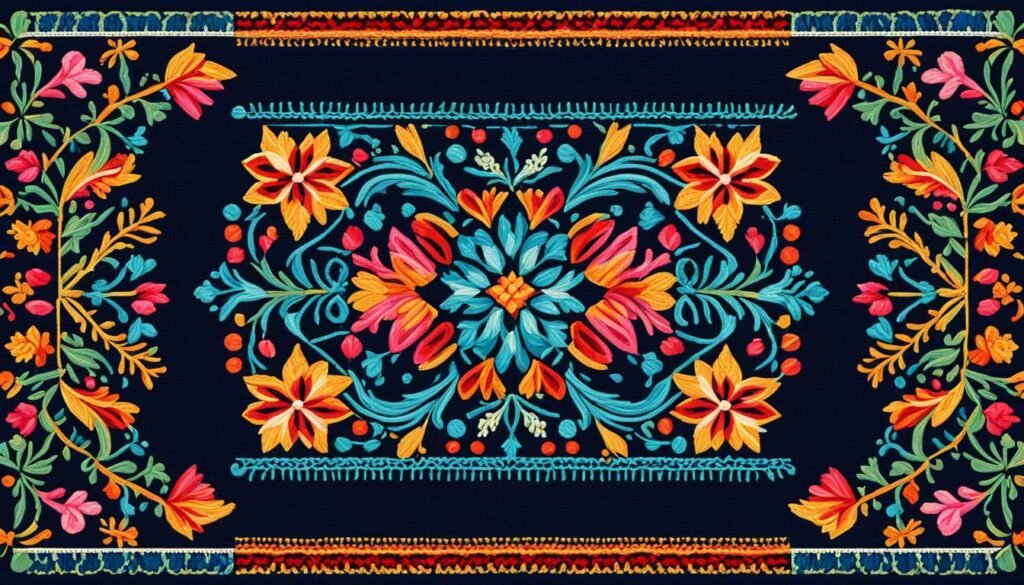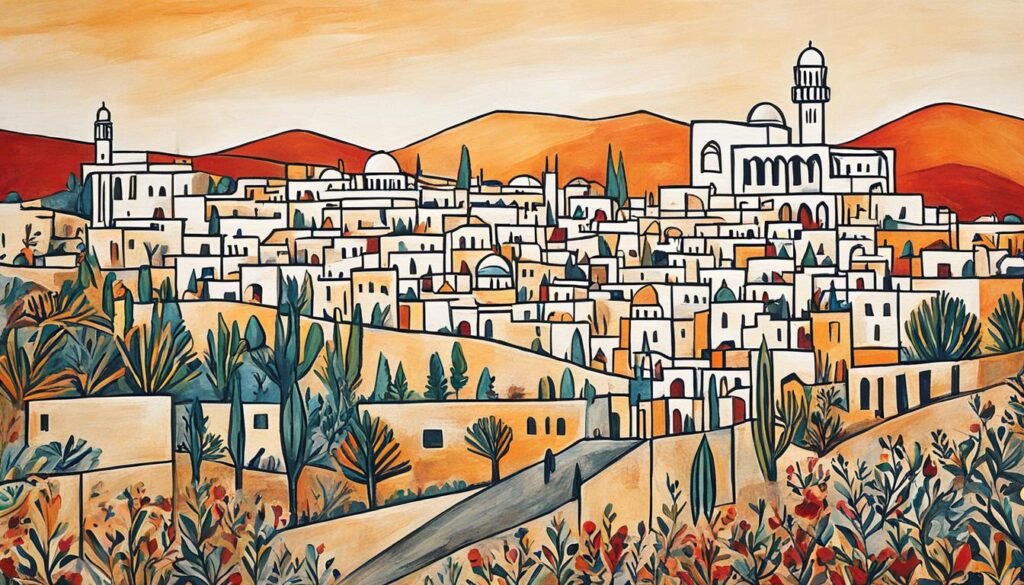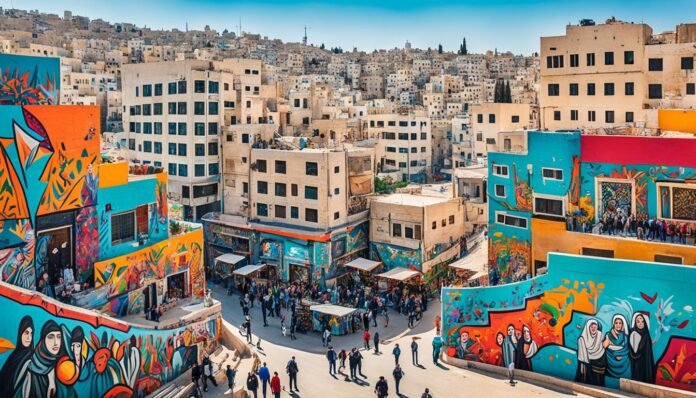Exploring Palestine art opens a door to the deep Palestinian cultural expression. Every artwork tells a story. It reflects the history, struggles, and resilience of the Palestinian people. Through Palestinian art history, we understand the impact of history on today’s art. This journey across different art forms connects us to the national identity in meaningful ways.
Key Takeaways
- Palestine art is a vital component of understanding Palestinian identity.
- Traditional and contemporary art forms reflect the unique heritage of the region.
- Exploration of Palestinian art history reveals the cultural ties of a resilient people.
- Art serves as a form of resistance and a medium for expressing the Palestinian experience.
- Contemporary Palestinian artists draw influence from both local and global contexts.
Introduction to Palestinian Art
Palestinian art showcases a rich mix of cultural expressions. It reflects the various experiences and identities within Palestinian society. Art serves as a way to tell stories. Artists use it to share personal and national tales that deeply touch their audience. An introduction to Palestinian artists shows how their art captures resilience, heritage, and identity struggles amid political unrest.
Art in Palestine is key in building cultural value. It gives a voice to experiences from the past and present. Artists work with traditional and modern methods, like pottery, embroidery, digital art, and performance. The colors and textures in their art include historical elements. They hold memories and hopes for the future.
Many Palestinian artists focus on themes of displacement, survival, and cultural pride. Noteworthy works show everyday life, family connections, and the beauty of the Palestinian landscape. They invite viewers to closely connect with the stories being told. This creative effort enhances the cultural scene. It also builds a feeling of unity among Palestinians around the world.
In recent years, the world has started to appreciate Palestinian art more. Artists have gained recognition in their communities and internationally. They blend traditional elements with modern approaches. This creates a lively and changing art scene.
| Art Form | Description | Cultural Significance |
|---|---|---|
| Painting | A mix of old and new methods, often showing personal and national stories. | Shows identity, history, and current issues. |
| Textile Art | Features detailed embroidery and fabric work, highlighting heritage. | Keeps traditions alive and displays creativity. |
| Performance Art | Covers theater, dance, and music, often with social and political messages. | Promotes discussion and brings communities together. |
The Historical Roots of Palestine Art
To understand historical roots of Palestine art, we must look at its varied past. The evolution of Palestinian art has been influenced by different historical events. These range from ancient times to current political movements. Through the years, changes in culture and politics have deeply affected artistic work.
The historical significance of Palestine art dates back to the Ottoman era. This period saw a blending of styles and traditions. Artists captured their life’s essence, telling stories through their art. With colonialism, new themes emerged. Art became a way to resist oppression and keep culture alive.
A key event in Palestinian art history was the Nakba in 1948. It caused massive displacement. This drastically changed the region and influenced the art deeply. Artists started to depict themes of loss, identity, and hope. Their work adds to a vast art collection that speaks of personal and shared stories.
The growth of Palestinian art shows a special strength and ongoing dialogue with its past. Every era had its challenges and victories. These have shaped the deep stories seen in today’s art shows. Palestinian artists stand out for their history and the powerful messages in their work. They connect with people across different cultures and eras.
Traditional Palestinian Art Forms
Traditional Palestinian art is a vibrant mix of culture. Embroidery and pottery are key parts of this culture. These crafts share stories about identity, history, and the Palestinian people’s creativity.
Embroidery and Textile Art
Embroidery is important in Palestinian art, especially for women. It shows their heritage and identity. Each pattern and stitch tells of skills handed down through generations.
The bright colors mean more than just beauty. They speak of local customs and stories. Traditional clothes with these designs show family, region, and social status. Every piece tells a personal story.
Pottery and Ceramics
Pottery is also key in Palestinian culture. It’s an old craft for making useful and decorative items. These pieces show the beauty of nature and local traditions.
Artisans get ideas from what’s around them. This shows in the designs and shapes they use. Pottery links practical use with art, keeping culture alive and bringing people together.

Contemporary Palestine Art: A New Perspective
Contemporary Palestine art showcases the vibrant work of modern Palestinian artists. They explore themes of society, politics, and more through their art. This art acts as a voice for personal and cultural stories, highlighting the struggle, resilience, and hope in their lives.
Modern Palestinian Artists
Modern Palestinian artists use various mediums to share their views. They blend traditional styles with modern approaches. Their work speaks to both local and global audiences. Artists like Banksy make street art in Bethlehem that questions social norms. Samira Badran’s paintings offer a strong visual commentary on life in Palestine.
Influence of Globalization on Palestinian Art
Globalization has brought new ideas to Palestinian art, mixing old and new styles. This mix creates a conversation between the past and the present in art. Art shows present this blend, showing how Palestinian art stays true to its roots while embracing change. Through global art movements, Palestinian creators share their unique stories with the world.
| Artist | Medium | Themes | Overview |
|---|---|---|---|
| Samira Badran | Painting | Identity, Heritage | Known for her vibrant colors, reflects Palestinian narratives through symbolic imagery. |
| Banksy | Street Art | Political Commentary | His works often challenge perceptions of conflict and resistance within urban landscapes. |
| Mahmoud Said | Photography | Documentary, Human Rights | Focuses on documenting daily life, shedding light on human rights issues in Palestine. |
| Hana Shalabi | Mixed Media | Social Justice, Women’s Rights | Combines photography and textiles to highlight women’s roles in society and activism. |
Palestine Art Exhibitions to Explore
Exploring art events in Palestine is a unique journey. It lets you dive into its deep culture and stories. These exhibits are alive with vibrant culture and diverse tales.
The Palestinian Museum is key for palestine art exhibitions. It features both well-known and new artists. Here, artworks reflect endurance and cultural identity. It’s a must-visit for art lovers.
The Quds Cultural Festival also stands out. It showcases the work of Palestinian artists and includes design, live performances, and talks. This festival mixes modern creativity with traditional themes, showing the growth of Palestinian art.
In cities like Ramallah, the Ramadan Art Festival is notable. It offers visual arts, music, and community activities. These events highlight talented artists and spur conversations on culture and societal issues.
These events are key in sharing Palestinian stories worldwide. They show the true essence and richness of Palestinian art. By attending, one can see how art deeply influences and saves culture and identity.
Prominent Palestinian Artists and Their Works
Palestinian art shines because of unique and creative Palestinian artists. They share their stories, culture, and the challenges facing Palestine. Their artwork combines old traditions and modern styles beautifully.
Elizabeth A. M. Zahran explores themes like being forced to leave home and staying strong. Her mixed media installations tell moving stories of Palestinian hardships. Then there’s Larissa Sansour, who makes people think with her videos and installations. Sansour’s work mixes science fiction with real stories, starting conversations about Palestine’s future.
These artists use different forms to show their incredible skills and to bring Palestine’s influential art closer to people. Their work not only looks amazing but also helps people understand and feel for Palestine. They play a big part in what makes contemporary art so important.
| Artist | Notable Works | Themes Explored |
|---|---|---|
| Elizabeth A. M. Zahran | “Echoes of Home” | Displacement, Memory, Resilience |
| Larissa Sansour | “A Modern History” | Conflict, Identity, Sci-fi Narratives |

Exploring Palestinian Cultural Expression Through Art
Art is key to Palestinian culture. It weaves a tapestry of creativity that makes people feel at home. It includes theatre, music, and visual arts for sharing cultural stories.
Visual arts show the daily life and the Palestinian experience’s complexity. This expression brings stories and memories to life. It gives insight into the community’s struggles. Theatre touches people’s hearts, sparking conversations about history and identity. Music reflects the community’s feelings. It connects people by their shared experiences and traditions.
Art is more than just showing life. It’s a way to resist and stay strong. It shows the culture’s power and creativity. This effort keeps the Palestinian heritage alive against odds. It makes sure their stories are celebrated.
- Theatre: Engaging through stories that highlight community challenges and victories.
- Visual Arts: Capturing everyday experiences and historical reflections.
- Music: Uniting people through melodies that speak to shared histories and traditions.
| Art Form | Purpose | Impact on Palestinian Society |
|---|---|---|
| Theatre | Engagement and storytelling | Fostering dialogue and understanding |
| Visual Arts | Reflection and representation | Preserving heritage and promoting awareness |
| Music | Emotional connection | Strengthening community bonds |
In conclusion, art in Palestinian culture keeps thriving as society changes. Its ability to adjust while staying true to its roots helps it resonate widely.
The Role of Art in Palestinian Identity
Art deeply shapes Palestinian identity and culture. It lets people express their unique cultural story and share it globally. Artists turn personal and shared challenges into art, reflecting on their lives and history.
Expressing identity through art shows resilience and hope. Art in forms like painting and sculpture carries the spirit of striving for recognition and unity. It makes people feel they belong and helps them face challenges while celebrating their heritage.
Art brings Palestinian communities together to support local artists and cultural events. It helps connect people, bridging gaps between generations. Artists share stories that honor their ancestors and motivate the youth through exhibitions and public art.
Art depicts struggles and dreams, creating impactful stories that are felt worldwide. Artists voice their community’s plea for recognition and understanding internationally. They document their reality and encourage others to connect with their narrative.
Finding Authentic Palestinian Art Online
Finding real Palestinian art online is now easy, thanks to the internet. There are many online Palestinian art galleries. They let us see the rich culture and deep feelings of Palestinian artists. These galleries display art from different times. This shows us the Palestinian identity through their art.
When you purchase Palestinian art, it’s good to support real artists and galleries. Artists often sell their work on their websites or social media. This way, you can really connect with them. Buying directly helps the artists and their communities. It also keeps their art traditions alive.
For collectors looking for real artwork, it’s smart to check out recommended galleries. This helps buyers find art they love and be sure it’s genuine. Here are some good choices:
| Gallery Name | Highlights | Website |
|---|---|---|
| Children of Al-Quds | Focus on contemporary themes, unique styles | Visit Here |
| Palestinian Museum | Traditional and modern art collections | Visit Here |
| Art Middle East | Features emerging artists, cultural themes | Visit Here |
Looking through these places offers a true shopping experience. It also celebrates Palestinian creativity and strength. Buying real Palestinian art online can make your collection better. It also supports the artists and their communities.
Palestinian Art Gallery Highlights
Discover the vibrant Palestinian art galleries and immerse yourself in culture and creativity. Each gallery showcases the soul of Palestinian artistry, making them must-visit spots for art lovers. The picks below include some of the top best galleries for Palestine art. They highlight both old and new pieces.
- Palestine Museum: Located in Ramallah’s core, this museum explores Palestinian heritage. It hosts exhibitions that depict the Palestinian people’s endurance and fight.
- Youth Cultural Center: A hub for emerging artists, it offers workshops and shows. These events raise cultural awareness through art.
- Dar El-Nimer for Arts and Culture: In Beirut, it’s vital for Palestinian artists. It houses contemporary artworks and presents shows that question social and political stories.
Reviews of art galleries often praise these places for showcasing different Palestinian views. The exhibitions do more than display art; they connect viewers with Palestinian culture’s larger story. To learn more about what’s happening in these palestinian art galleries, check out this resource. It offers detailed insights into their artistic scene.
Exploring these galleries deeply enhances understanding of Palestinian life and struggles through art. With everything from detailed crafts to striking modern pieces, these venues capture Palestinian culture’s heart.
Conclusion
Palestine’s art tells a deep story. It’s a mix of history, tradition, and strength. It includes many forms, like embroidery and ceramics. This art reflects the people’s identity, culture, and unity. Every piece has its own story. It shows hope and resilience in tough times.
This look into Palestinian art highlights its role beyond just beauty. It helps keep culture alive. Today’s artists link the past with the now. They make art that the whole world can feel, while staying true to their heritage. Palestinian art continues to grow. It shows a strong spirit and creativity that earns worldwide respect.
In exploring Palestinian art, see it as a celebration. It’s about diversity, overcoming hard times, and the power of community. This art goes beyond borders. It touches hearts. It helps all understand the beauty of this cultural path. By supporting this art, we keep the conversation about identity and Palestine’s legacy alive.
